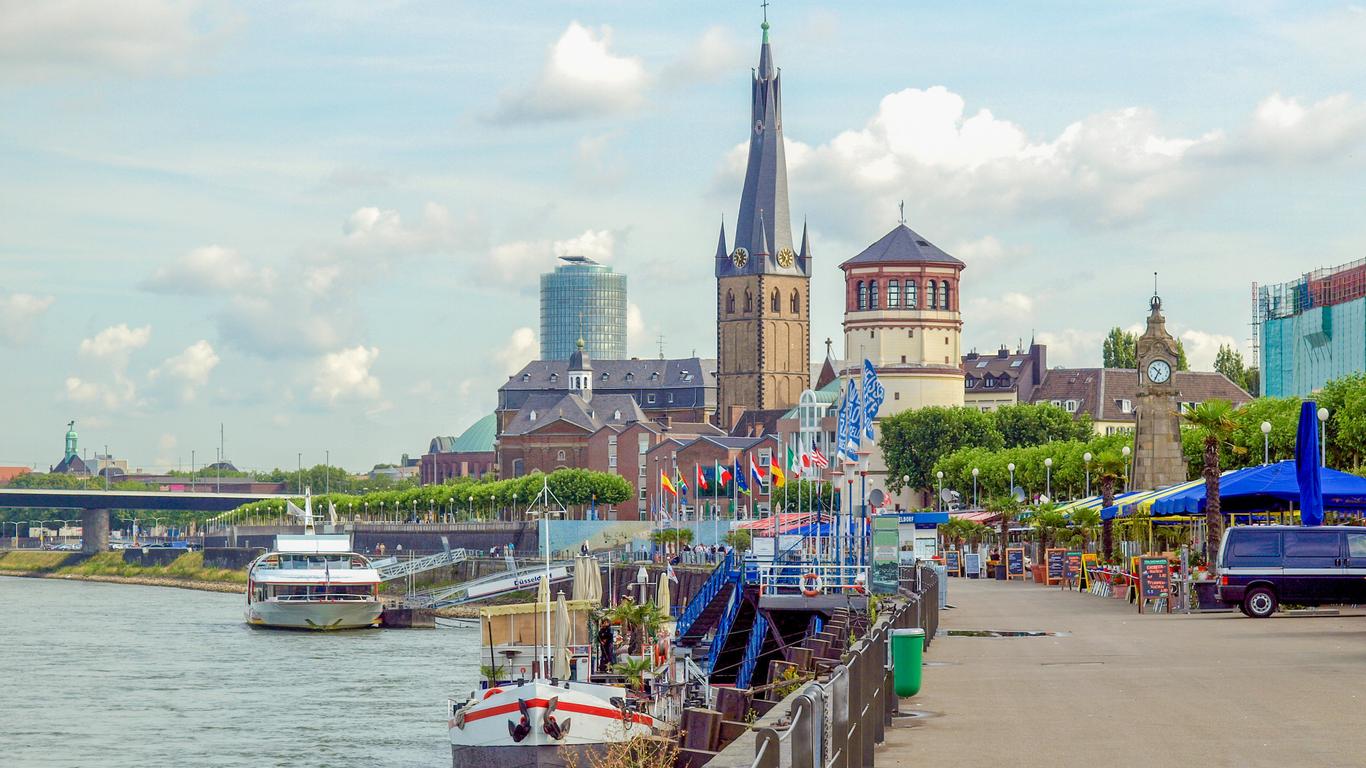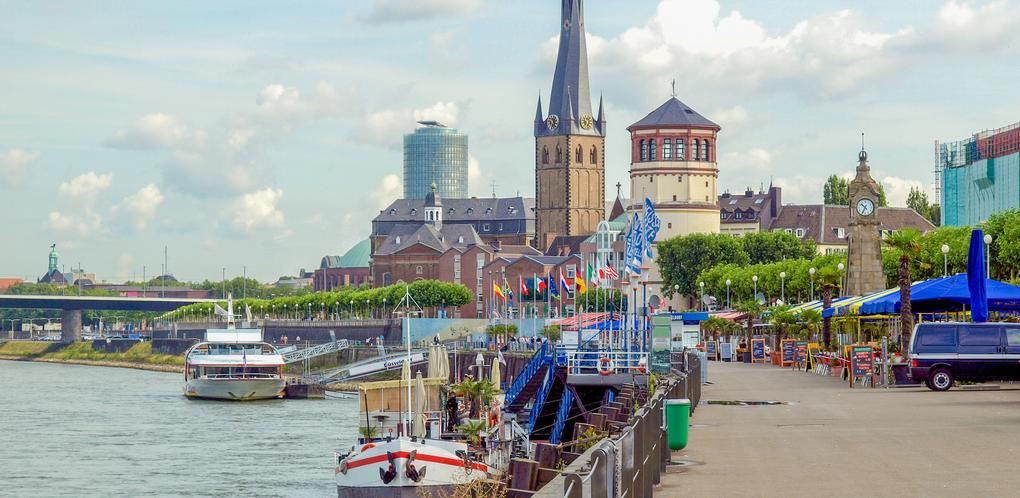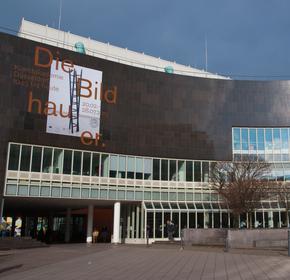
Düsseldorf travel guide
Düsseldorf Tourism | Düsseldorf Guide
You're Going to Love Düsseldorf
Düsseldorf is a center for commerce and the arts, with a striking collection of avant-garde buildings. It's also home to the "longest bar in the world" - a string of over 260 bars, lounges, and nightclubs in the Altstadt. Düsseldorf welcomes visitors with a hospitable flair and a lot to offer.

Top 5 Reasons to Visit Düsseldorf
1. Architecture Old and New
The Altstadt (Old City) was lovingly restored, and you'll be able admire the medieval and Baroque masterpieces like the Andreaskirche from the early 17th century alongside modern gems designed by world-renowned architects like Frank Gehry, Jo Coenen, and Claude Vasconi.
2. Scintillating Nightlife
The Altstadt is home to a lively bar-hopping scene in historic surroundings, with many of the bars doubling as brewers and selling their own beer.
3. Cutting-Edge Arts Scene
Fashion, broadcasting, and advertising - along with film and fine art - form a big part of life in Düsseldorf, with everything from galleries to film festivals, fashion events, and much more to experience.
4. Fabulous Shopping
You'll find chic boutiques in the Altstadt, big department stores like Breuninger, and huge hypermalls in the suburban areas.
5. Food and Drink
From a craft brew and pig's knuckles at a bar in the Altstadt to high-end fusion cuisine at a sleek dining lounge, there are choices to please every palate in Düsseldorf.
What to do in Düsseldorf
1. Königsallee: A Street Fit for a King
The Königsallee boulevard extends from Hofgarten, a major park in the downtown area at Elberfelder Straße, about 1km/0.6 miles south of Luisenstraße, with a peaceful canal and green space that runs down its center. Shops line the eastern side of the boulevard, while the quieter western side is occupied by hotels, banks, and other businesses. The retail area is a focal point for the fashion industry, and includes many upscale designer stores and showrooms. There are many cafes, restaurants, and night clubs located on either side of the canal. The boulevard is located next to the Altstadt or Old Town.
2. Rheinturm: Tower of the Rhine
At just under 790 feet, the Rheinturm or Rhine Tower is the tallest structure in Düsseldorf. The telecommunication tower is constructed of concrete, with an observation deck offering views from just under 558 feet in height, including the bustling Königsallee and various bridges over the river Rhine. The deck is open daily to the public and accessible by elevator. There is a revolving restaurant with glass walls allowing visitors to wine and dine at a height of 565 feet. The shaft of the tower incorporates a spectacular light sculpture called Lichtzeitpegel (Light Time Level) whose beams produce the largest digital clock in the world. The Rheinturm is located next to the state of North Rhine-Westphalian parliament buildings.
3. K20: Part of the Kunstsammlung Nordrhein-Westfalen
The K20 is an enchanting art museum, and together with the K21 and the Schmela Haus, the three institutions house the official art collection of the state of Nordrhein-Westfalen. The K20 boasts an impressive collection of 20th-century works, including important pieces by Picasso, Matisse, Dali, and Paul Klee, among many others. Along with its world-renowned permanent collection, the museum hosts temporary exhibits throughout the year, along with periodic events the public may attend.
4. Kaiserswerth: If it's Not Baroque, Don't Fix It
One of the city's oldest districts, Kaiserswerth is located in the northern part of Düsseldorf. The neighborhood is home to many fine examples of ornate Baroque-era architecture from the 17th and 18th centuries. The 12th-century ruins of the Kaiserpfalz, the royal palace of Emperor Friedrich Barbarossa, are located in this area along the Rhine, surrounded by a stone wall. St. Suitbertus Bascilica also calls Kaiserswerth its home, a classic Romanesque basilica that incorporates a shrine with gilded decoration. Cafes, restaurants, and beer gardens are also scattered throughout the neighborhood.
5. UNESCO-Welterbe Zollverein: A UNESCO World Heritage Site
This former industrial site is part of the European Route of Industrial Heritage. First developed in 1847 as a coal mine, it remains open as a monument to the coal industry which created one of the world's largest industrial centers at the time. The complex, and Shaft 12 in particular, is considered an impressive example of industrial and architectural design. The Ruhr Museum is located in the former Coal Washery, and includes over 6,000 exhibits relating to the history of coal mining in the area, along with temporary exhibits, and a calendar of events.


1. Königsallee: A Street Fit for a King
The Königsallee boulevard extends from Hofgarten, a major park in the downtown area at Elberfelder Straße, about 1km/0.6 miles south of Luisenstraße, with a peaceful canal and green space that runs down its center. Shops line the eastern side of the boulevard, while the quieter western side is occupied by hotels, banks, and other businesses. The retail area is a focal point for the fashion industry, and includes many upscale designer stores and showrooms. There are many cafes, restaurants, and night clubs located on either side of the canal. The boulevard is located next to the Altstadt or Old Town.
2. Rheinturm: Tower of the Rhine
At just under 790 feet, the Rheinturm or Rhine Tower is the tallest structure in Düsseldorf. The telecommunication tower is constructed of concrete, with an observation deck offering views from just under 558 feet in height, including the bustling Königsallee and various bridges over the river Rhine. The deck is open daily to the public and accessible by elevator. There is a revolving restaurant with glass walls allowing visitors to wine and dine at a height of 565 feet. The shaft of the tower incorporates a spectacular light sculpture called Lichtzeitpegel (Light Time Level) whose beams produce the largest digital clock in the world. The Rheinturm is located next to the state of North Rhine-Westphalian parliament buildings.
3. K20: Part of the Kunstsammlung Nordrhein-Westfalen
The K20 is an enchanting art museum, and together with the K21 and the Schmela Haus, the three institutions house the official art collection of the state of Nordrhein-Westfalen. The K20 boasts an impressive collection of 20th-century works, including important pieces by Picasso, Matisse, Dali, and Paul Klee, among many others. Along with its world-renowned permanent collection, the museum hosts temporary exhibits throughout the year, along with periodic events the public may attend.
4. Kaiserswerth: If it's Not Baroque, Don't Fix It
One of the city's oldest districts, Kaiserswerth is located in the northern part of Düsseldorf. The neighborhood is home to many fine examples of ornate Baroque-era architecture from the 17th and 18th centuries. The 12th-century ruins of the Kaiserpfalz, the royal palace of Emperor Friedrich Barbarossa, are located in this area along the Rhine, surrounded by a stone wall. St. Suitbertus Bascilica also calls Kaiserswerth its home, a classic Romanesque basilica that incorporates a shrine with gilded decoration. Cafes, restaurants, and beer gardens are also scattered throughout the neighborhood.
5. UNESCO-Welterbe Zollverein: A UNESCO World Heritage Site
This former industrial site is part of the European Route of Industrial Heritage. First developed in 1847 as a coal mine, it remains open as a monument to the coal industry which created one of the world's largest industrial centers at the time. The complex, and Shaft 12 in particular, is considered an impressive example of industrial and architectural design. The Ruhr Museum is located in the former Coal Washery, and includes over 6,000 exhibits relating to the history of coal mining in the area, along with temporary exhibits, and a calendar of events.


Where to Eat in Düsseldorf
Carlsplatz occupies an old fruit market, offering a huge array of options that include cafe-style fare, high-end vendors, takeaway, and much more, with mains starting at only EUR5. Münstermann Kontor is a modern bistro, with locally sourced ingredients and a seasonal menu that starts at EUR20.
When to visit Düsseldorf
Most visitors come to Düsseldorf between April and October, when daily temperatures are 60 degrees Fahrenheit or above, however, there is a stream of tourism to the city year round.
How to Get to Düsseldorf
Plane
Düsseldorf Airport (DUS) is located just over 9 miles from the city center. Regular bus service to the city is available from EUR3.80, while a taxi costs about EUR15-20.
Train
The main station, Düsseldorf Hauptbahnhof, links to all major centers in Germany and beyond throughout Europe.
Car
The city connects to the rest of Germany via the Autobahn network in virtually all directions, including highways A3, A44, A46, A52, A57, and A59.
Bus
Düsseldorf is a hub for IC Bus - NS International, with connections via the main bus station throughout Germany, as well as centers in Belgium, France, and the Netherlands.
Airlines serving Düsseldorf
Where to stay in Düsseldorf
Altstadt - the historic heart of the city is home to a hip nightlife scene, along with major art galleries and attractions like the Kunstsammlung Nordrhein-Westfalen and the Filmmuseum.
Popular Neighborhoods in Düsseldorf
Flingern - this recently renovated neighborhood has a bohemian flair and an artsy vibe, as well some great nightlife options with places like Stahlwerk, a legendary techno club.
MedienHafen - modern architecture and a string of lively restaurants and hotels have sprouted in this harborside district.
Where to stay in popular areas of Düsseldorf
Most booked hotels in Düsseldorf
How to Get Around Düsseldorf
Public Transportation
There is an extensive network of public transportation in the city, including bus, trams, and subways. A short-trip ticket, good for 3-4 stops, costs EUR1.60, and a regular ticket anywhere in the city, valid for 90 minutes, costs EUR2.50.
Taxi
Taxis are plentiful in the city. The starting fare is EUR5, with an additional EUR2.20 for each 0.6 mile.
Car
A car isn't necessary but it can be an option for getting around the city, provided your vehicle displays a sticker showing compliance with local environmental regulations. A compact rental costs about EUR55, and Europcar can be found in town.
The Cost of Living in Düsseldorf
Shopping Streets
The best shopping in the city is centered around Königsallee, where you can stroll along the landscaped canal between your purchases.
Groceries and Other
You'll find a wide range of products and reasonable prices at REWE city and Kaufland. A gallon of milk costs about EUR2.75, and a dozen eggs about EUR2.60.

